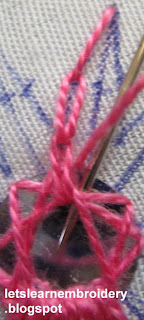Please follow these
instructions to embroider a carnation, seen from the side.The thread used is
pearl cotton no:8.
This flower design is my own creation.You are not allowed to copy the tutorial and produce it as your own whether on print or electronic media, on your blog or youtube channels.You are allowed to show the finished work but please link back to this page for the tutorial.
This flower design is my own creation.You are not allowed to copy the tutorial and produce it as your own whether on print or electronic media, on your blog or youtube channels.You are allowed to show the finished work but please link back to this page for the tutorial.
Embroider a serrated-edged (zig-zag)
buttonhole/blanket stitch petal as shown.
Work 2 more layers of zig-zag stitches (total 3
layers).
With 2 strands of thread, work buttonhole knots
on the 3 layers.
Gather the buttonhole/blanket stitch petal and
embroider satin stitch, done from top to bottom to form a calyx.























































